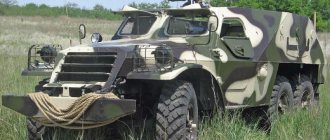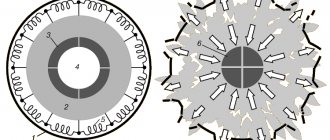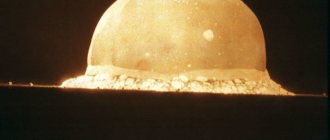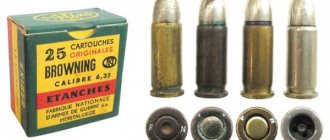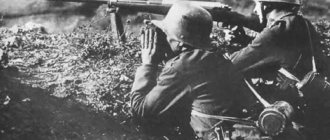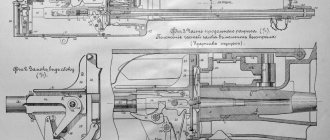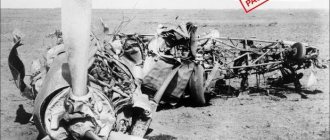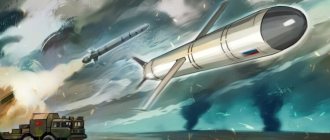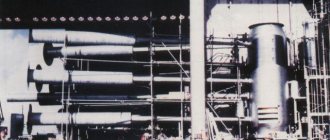Nuclear weapons are strategic weapons capable of solving global problems. Its use is associated with dire consequences for all humanity. This makes the atomic bomb not only a threat, but also a weapon of deterrence.
The appearance of weapons capable of putting an end to the development of mankind marked the beginning of a new era. The likelihood of a global conflict or a new world war is minimized due to the possibility of total destruction of the entire civilization.
Despite such threats, nuclear weapons continue to be in service with the leading countries of the world. To a certain extent, it is this that becomes the determining factor in international diplomacy and geopolitics.
The history of the creation of the nuclear bomb
Models of the “Little Boy” and “Fat Man” bombs dropped on Japanese cities
The question of who invented the nuclear bomb does not have a clear answer in history. The discovery of the radioactivity of uranium is considered to be a prerequisite for work on atomic weapons. In 1896, the French chemist A. Becquerel discovered the chain reaction of this element, marking the beginning of developments in nuclear physics.
In the next decade, alpha, beta and gamma rays were discovered, as well as a number of radioactive isotopes of certain chemical elements. The subsequent discovery of the law of radioactive decay of the atom became the beginning for the study of nuclear isometry.
In December 1938, German physicists O. Hahn and F. Strassmann were the first to carry out a nuclear fission reaction under artificial conditions. On April 24, 1939, the German leadership was informed about the possibility of creating a new powerful explosive.
However, the German nuclear program was doomed to failure. Despite the successful progress of scientists, the country, due to the war, constantly experienced difficulties with resources, especially with the supply of heavy water. In the later stages, research was slowed down by constant evacuations. On April 23, 1945, the developments of German scientists were captured in Haigerloch and taken to the USA.
The United States became the first country to express interest in the new invention. In 1941, significant funds were allocated for its development and creation. The first tests took place on July 16, 1945. Less than a month later, the United States used nuclear weapons for the first time, dropping two bombs on Hiroshima and Nagasaki.
The USSR's own research in the field of nuclear physics has been conducted since 1918. The Commission on the Atomic Nucleus was created in 1938 at the Academy of Sciences. However, with the outbreak of the war, its activities in this direction were suspended.
In 1943, information about scientific works in nuclear physics was received by Soviet intelligence officers from England. Agents were introduced into several US research centers. The information they obtained allowed them to accelerate the development of their own nuclear weapons.
The invention of the Soviet atomic bomb was led by I. Kurchatov and Yu. Khariton, they are considered the creators of the Soviet atomic bomb. Information about this became the impetus for the US preparation for preemptive war. In July 1949, the Trojan plan was developed, according to which it was planned to begin military operations on January 1, 1950.
The date was later moved to early 1957 so that all NATO countries could prepare and join the war. According to Western intelligence, nuclear weapons testing in the USSR could not have been carried out until 1954.
However, US preparations for war became known in advance, which forced Soviet scientists to speed up their research. In a short time they invent and create their own nuclear bomb. On August 29, 1949, the first Soviet atomic bomb RDS-1 (special jet engine) was tested at the test site in Semipalatinsk.
Such tests thwarted the Trojan plan. From that moment on, the United States ceased to have a monopoly on nuclear weapons. Regardless of the strength of the preemptive strike, there remained the risk of retaliatory action, which could lead to disaster. From that moment on, the most terrible weapon became the guarantor of peace between the great powers.
The first atomic bomb test. Birth of the era of atomic weapons
Now the nuclear potential of some countries is simply amazing. In this area, the laurels of primacy belong to the United States. This power has a nuclear arsenal of more than 5
thousand units.
The nuclear age began more than 70
years ago, after the first atomic bomb test took place in New Mexico at the Alamogordo test site.
This event marked the beginning of the era of atomic weapons. Since then, another 2,062 nuclear bombs have been tested around the world. Of these, 1032
tests were carried out by the USA (1945-1992),
715
by the USSR (1949-1990),
210
by France (1960-1996),
45 each
by Great Britain (1952-1991) and China (1964-1996),
6 each
– India (1974-1998) and Pakistan (1998), and
3
– DPRK (2006, 2009, 2013).
Reasons for creating a nuclear bomb
The first steps towards the creation of nuclear weapons were taken in 1939
. The main reason for this was the activities of Nazi Germany, which was preparing for war. Several people considered the idea of creating weapons of mass destruction. This fact alarmed opponents of the Hitler regime and prompted an appeal to US President Franklin Roosevelt.
Project history
In 1939
, several scientists approached Roosevelt.
These were Albert Einstein, Leo Szilard, Edward Teller and Eugene Wigner. In their letter, they expressed concern about the development of a new type of powerful bomb in Germany. Scientists were afraid that Germany would create a bomb earlier, which could cause destruction on a huge scale. The message also said that thanks to research in the field of atomic physics, it became possible to use the effect of atomic decay to create atomic weapons. The US President took the message with due attention and, on his orders, a uranium committee was created. On October 21 , 1939
, at a meeting it was decided to use uranium and plutonium as raw materials for the bomb.
The project developed very slowly and at first was only of a research nature. This continued almost until 1941
.
Scientists did not like this slow progress, and March 7, 1940
, another letter was sent on behalf of Albert Einstein to Franklin Roosevelt.
Information has emerged that Germany is showing strong interest in creating new powerful weapons. Thanks to this, the process of creating a bomb by the Americans accelerated, because in this case there was already a more serious question - a question of survival. Who knows what could have happened if German scientists, during World War II, had created the bomb first. The atomic program was approved by the US President October 9 1941
and was called the Manhattan Project.
The project was carried out by the United States in cooperation with Canada and Great Britain. The work was carried out in complete secrecy. In this regard, it was given this name. Initially, they wanted to call it “Development of Substitute Materials,” which literally translates as “Development of Alternative Materials.” It was clear that such a name could attract unwanted outside interest, and therefore it received the optimal name. To construct the complex to implement the program, the Manhattan Engineering District was created, hence the name of the project. There is another version of the origin of the name. It is believed that it came from New York Manhattan, where Columbia University is located. At an early stage of work, most of the research was carried out there. Work on the project took place with the participation of more than 125
thousand people.
A huge amount of material, industrial and financial resources have been lost. In total, 2
billion was spent on creating and testing the bomb.
The country's best minds worked on the creation of weapons. Practical work on creating the first nuclear bomb began in 1943
.
Research institutes in the fields of nuclear physics, chemistry, and biology were established in Los Alamos (New Mexico), Hartford (Washington State) and Oak Ridge (Tennessee). The first three atomic bombs were created in mid- 1945
. They differed in the type of action (cannon, gun and implosion type) and in the type of substance (uranium and plutonium).
Preparing for a bomb test
To conduct the first atomic bomb test, the location was selected in advance. For this purpose, a sparsely populated region of the country was chosen. An important condition was the absence of Indians in the area. The reasons for this were the difficult relationship between the leadership of the Bureau of Indian Affairs and the leadership of the Manhattan Project. As a result, at the end 1944
, the Alamogordo area, which is located in the state of New Mexico, was chosen.
Planning for the operation began in 1944
.
She was given the code name "Trinity". In preparation for the test, the option of the bomb not detonating was considered. For this case, a steel container was ordered that can withstand the explosion of a conventional bomb. This was done so that, in the event of a negative result, at least part of the plutonium would be preserved, and also to prevent it from polluting the environment. The bomb was codenamed "Gadget". It was installed on a steel tower 30
meters high. Two plutonium hemispheres were installed into the bomb at the last moment.
The first atomic bomb explosion in human history
The explosion was planned to take place July 16 , 1945
at
4:00
am local time.
But it had to be carried through weather conditions. The rain stopped and at
5:30
am
the explosion occurred.
As a result of the explosion, the steel tower evaporated, and in its place a crater with a diameter of about 76
meters was formed.
The light from the explosion could be seen at a distance of about 290
kilometers.
The sound spread over a distance of about 160
kilometers.
In this regard, it was necessary to spread misinformation about the explosion of ammunition. The mushroom cloud rose to 12
kilometers in five minutes.
It consisted of radioactive substances, iron vapor and several tons of dust. After the operation, radiation contamination of the environment was observed at a distance of 160
kilometers from the epicenter of the explosion.
A five-meter iron pipe with a diameter of 10
centimeters, which was concreted and reinforced with guy wires, also evaporated at
150
meters.
The results of the Manhattan Project could be considered a success. The main participants were adequately rewarded. Scientists from Canada, Great Britain and the USA, emigrants from Germany and Denmark took part in it. It was this project that marked the beginning of the atomic era. Nowadays, many powers have an impressive atomic arsenal, but, fortunately, history remembers only two cases of the use of nuclear bombs against humanity - the bombings of Hiroshima and Nagasaki on August 6
and
9 1945 .
Principle of operation
The principle of operation is the combination of charges to create a critical mass and a subsequent chain reaction.
The principle of operation of an atomic bomb is based on a chain reaction of the decay of heavy nuclei or thermonuclear fusion of light ones. During these processes, a huge amount of energy is released, which turns the bomb into a weapon of mass destruction.
The principle of a nuclear bomb explosion has several damaging factors:
- light flash;
- radioactive contamination;
- shock wave;
- penetrating radiation;
- electromagnetic pulse.
A flash of light, accompanied by thermal radiation, is formed first. Its power significantly exceeds the power of the sun's rays, which makes the explosion dangerous at a distance of several kilometers from the epicenter.
Radiation also poses a danger: within a minute its penetrating power is highest. In the future, it causes radiation sickness in humans and animals.
The shock wave has a high degree of damage at a distance of several hundred meters from the epicenter. There is nothing alive or whole left in this radius. As you move away from the center, the degree of damage decreases.
An electromagnetic pulse (EMP), the most “harmless” consequence of a nuclear explosion, leads to the shutdown of electronics. It causes harm to living organisms if they are dependent on electronic devices. At the same time, lamp and photonic equipment has good resistance to EMR.
From kilotons to megatons
The first atomic bombs of the “cannon design” bore little resemblance to their successors and were even made on the basis of cutting a real cannon barrel, fortunately, these barrels were made of excellent steel, which gave a chance for a successful detonation of the charge before the rapid heating of the device structure in the very first fractions of a second of reaction will rupture the assembly, preventing any significant amount of nuclear energy from being released.
But already the second combat “product”, dropped on Nagasaki on August 9, 1945, was a significant step forward. It used the so-called “implosive circuit,” which provides a more controlled process of charge initiation and, in addition, saves nuclear materials, since under the high pressure of the explosion of a conventional explosive, the critical mass of fissile material necessary to start a chain reaction is noticeably reduced.
Nuclear mushroom over Nagasaki
Photo: AP
It was the geometry of the device that predetermined the appearance of the first bombs: the elongated uranium “Baby” of the “cannon design” and the round plutonium “Fat Man” - the implosive one.
In fact, the “cannon scheme” exhausted itself during the same period of the zero generation of nuclear warheads, ending with a series of ammunition for conventional large-caliber barrel artillery. However, this generation of bomb helped the military realize the fact that nuclear weapons can be used directly on the battlefield, and not just serve as a “big stick” on a strategic scale. It was urgently necessary to adapt the battlefield, the organization of troops, their tactics and military equipment to the new reality. The battlefield suddenly became empty. Survival and preservation of combat-ready enemy units in the nuclear strike zone of the attacking side looked problematic, but we had to think about protecting our units from the long-term damaging factors of our own strike potential. Combat formations became looser: the zone that had previously been occupied by a division in the offensive or defensive was now occupied by a battalion.
Meanwhile, a nuclear race began in design bureaus and research institutes, which began with the success of “Fat Man,” which demonstrated both high controllability and sufficient safety of the process of producing new and storing accumulated nuclear weapons. This race continues today.
Its first round looked like a simple increase in the power of any individual ammunition, which any heavy bomber that broke into enemy airspace could deliver to its target. In the United States, the high level of losses of bomber aviation, recognized as inevitable by the results of command and staff modeling, required that even a single carrier aircraft inflict maximum damage on the enemy. For the USSR, this issue was even more critical, since the Soviet Air Force could count on a single retaliatory bombing strike on US territory, without the prospect of returning to its airfields: the Soviet Union did not have bases near the United States, and the route there and back for the first Soviet nuclear carriers weapons - Tu-4 bombers - was too far away.
Strategic bomber Tu-4
Photo: Vitaly Arutyunov / RIA Novosti
Thermonuclear (aka hydrogen) charges, urgently developed by both main sides of the nuclear race, made it possible to immediately move on to increasing the destructive capabilities of strategic means of warfare. The tests of the 1950s themselves became a kind of nuclear war - simply strikes were carried out by both sides on their territory, but with all the damaging factors due.
On the other hand, during the testing process, those features of the new weapon were revealed that forced politicians to slow down overly zealous military men like MacArthur. So the most dangerous period for the world was the period when neither the leaders of the powers nor their military commanders yet understood these very features with sufficient clarity.
In general, with the advent of the Eisenhower administration in the White House, and in the USSR with the development of Khrushchev’s political transformations, the immediate threat of a new world war receded. But the nuclear race continued to escalate. Entire industrial sectors developed rapidly. The exponential growth of scientific, technical and production potential involved in nuclear programs opened up new horizons and opportunities.
Thermonuclear charges are the first devices in which the final explosion was the result of a three-step physical process. The detonation of conventional explosives activated the nuclear fuse of the hydrogen (that is, thermonuclear) ammunition. Yes, at that time all the tricks were aimed at increasing the power of a single charge: a megaton, ten megatons, and so on, until the notorious “Kuzka’s mother” raised the bar to hundreds of megatons (tests were carried out with a sample of “reduced” power of 58 megatons). But nuclear scientists were already thinking about complicating this “magnificent physical experiment” by achieving new, previously unknown effects that could be used to further improve the Bomb.
Oddly enough, Kuzka's mother, also known as Mother of Kuzma (the meaning of the literal translation from Russian had to be conveyed by Western editors in a long interlinear version) was not at all intended to strike US cities. It seemed much more profitable to deliver a one-time strike across the entire continent, and the bet was placed not on a shock wave, penetrating radiation or thermal radiation from a “fireball”, but on a super-powerful electromagnetic pulse that would disable the entire power system of North America, all communication systems and even secure electronic devices. That is, to deprive the United States and NATO of those advantages that, by and large, ensured the technical superiority of the fleets, air forces and armies of the West.
The question, however, was the means of delivering such weapons to the target. At the time of testing, it could only be a specially equipped bomber; missiles of the required class simply did not exist. And the history of the Bomb turned into the history of nuclear missile weapons, where one is inseparable from the other.
Awareness of the consequences of the massive use of nuclear weapons, meanwhile, has given rise to many new things in national doctrines and in the armed forces.
In particular, US strategists were convinced that it was impossible to beat the USSR in the “Big Club Race”. In response to the Titan I with a 3.75 megaton Mk4 warhead, the USSR deployed the cheaper R-9 with a 5 megaton warhead in approximately the same quantities. In response to the Titan II with the heaviest warhead in the US Air Force, the nine-megaton (according to other sources, its power ranged from 10 to 15 megatons) Mk6, the P-16 appeared, practically not lagging behind it. Inferior to the Titan in terms of warhead power (in the light version - three, in the heavy version - six megatons), it could be produced in noticeable quantities and, adopted for service in early 1963, formed the basis of the USSR Strategic Missile Forces.
Launch of the Titan I ICBM from Vandenberg Air Force Base, California
Photo: PhotoQuest/Getty Images/Fotobank
Even the few Soviet missiles proved capable of destroying war-fighting capabilities and perhaps even calling into question the survival of the United States as a power. As a result, Washington abandoned the complete subordination of the development of its armed forces to the doctrine of global war with the full-scale use of strategic nuclear weapons. And for the United States, strategic nuclear weapons remained precisely the means to keep the USSR from resolving the issue militarily in a critical situation.
First bomb tests
Atomic bomb test, explosion
The US nuclear program was called the Manhattan Project. Began to operate on September 17, 1943. The first tests of an atomic bomb within the framework of this program took place on July 16, 1945, under the code name “Trinity”.
On August 29, 1949, the inventors of the Soviet atomic bomb, Yu. Khariton and I. Kurchatov, successfully tested the RDS-1. The first warheads were experimental, without delivery vehicles. However, the very fact of their presence was enough to prevent the Third World War.
On September 24, 1951, tests of the RDS-2 were carried out. They could already be delivered to the launch points so that they could reach the United States. On October 18, the RDS-3, delivered by bomber, was tested.
Further testing moved on to thermonuclear fusion. The first tests of such a bomb in the United States took place on November 1, 1952. In the USSR, such a warhead was tested within 8 months.
TX nuclear bomb
Scheme of RDS-1
Nuclear bombs do not have clear characteristics due to the variety of uses of such ammunition. However, there are a number of general aspects that must be taken into account when creating this weapon.
These include:
- axisymmetric structure of the bomb - all blocks and systems are placed in pairs in cylindrical, spherocylindrical or conical containers;
- when designing, they reduce the mass of a nuclear bomb by combining power units, choosing the optimal shape of shells and compartments, as well as using more durable materials;
- minimize the number of wires and connectors, and use a pneumatic line or explosive detonation cord to transmit the impact;
- blocking of the main components is carried out using partitions that are destroyed by pyroelectric charges;
- active substances are pumped using a separate container or external carrier.
Taking into account the requirements for the device, a nuclear bomb consists of the following components:
- a housing that provides protection for ammunition from physical and thermal effects - divided into compartments and can be equipped with a load-bearing frame;
- nuclear charge with power mount;
- self-destruction system with its integration into a nuclear charge;
- a power source designed for long-term storage - activated already during rocket launch;
- external sensors - to collect information;
- cocking, control and detonation systems, the latter embedded in the charge;
- systems for diagnostics, heating and maintaining a microclimate inside sealed compartments.
Depending on the type of nuclear bomb, other systems are also integrated into it. These may include a flight sensor, a locking remote control, calculation of flight options, and an autopilot. Some munitions also use jammers designed to reduce resistance to a nuclear bomb.
The consequences of using such a bomb
Destruction in Nagasaki after the atomic bombing
The “ideal” consequences of the use of nuclear weapons were already recorded when the bomb was dropped on Hiroshima. The charge exploded at an altitude of 200 meters, which caused a strong shock wave. Coal-fired stoves were knocked over in many homes, causing fires even outside the affected area.
The flash of light was followed by a heat stroke that lasted a matter of seconds. However, its power was enough to melt tiles and quartz within a radius of 4 km, as well as spray telegraph poles.
The heat wave was followed by a shock wave. The wind speed reached 800 km/h, its gust destroyed almost all buildings in the city. Of the 76 thousand buildings, about 6 thousand partially survived, the rest were completely destroyed.
The heat wave, as well as rising steam and ash, caused heavy condensation in the atmosphere. A few minutes later it began to rain with drops of ash black. Contact with the skin caused severe incurable burns.
People who were within 800 meters of the epicenter of the explosion were burned to dust. Those who remained were exposed to radiation and radiation sickness. Its symptoms were weakness, nausea, vomiting, and fever. There was a sharp decrease in the number of white cells in the blood.
In seconds, about 70 thousand people were killed. The same number subsequently died from their wounds and burns.
Three days later, another bomb was dropped on Nagasaki with similar consequences.
Stockpiles of nuclear weapons in the world
Stockpiles of nuclear weapons in the world
The main stockpiles of nuclear weapons are concentrated in Russia and the United States. In addition to them, the following countries have atomic bombs:
- Great Britain - since 1952;
- France - since 1960;
- China - since 1964;
- India - since 1974;
- Pakistan - since 1998;
- DPRK - since 2008.
Israel also possesses nuclear weapons, although there has been no official confirmation from the country's leadership.
There are US bombs on the territory of NATO countries: Germany, Belgium, the Netherlands, Italy, Turkey and Canada. The US allies, Japan and South Korea, also have them, although the countries have officially abandoned the location of nuclear weapons on their territory.
After the collapse of the USSR, Ukraine, Kazakhstan and Belarus briefly had nuclear weapons. However, it was later transferred to Russia, which made it the sole heir to the USSR in terms of nuclear weapons.
The number of atomic bombs in the world changed during the second half of the 20th century and the beginning of the 21st century:
- 1947 - 32 warheads, all from the USA;
- 1952 - about a thousand bombs from the USA and 50 from the USSR;
- 1957 - more than 7 thousand warheads, nuclear weapons appear in Great Britain;
- 1967 - 30 thousand bombs, including weapons from France and China;
- 1977 - 50 thousand, including Indian warheads;
- 1987 - about 63 thousand, - the highest concentration of nuclear weapons;
- 1992 - less than 40 thousand warheads;
- 2010 - about 20 thousand;
- 2018 - about 15 thousand.
It should be borne in mind that these calculations do not include tactical nuclear weapons. This has a lower degree of damage and variety in carriers and applications. Significant stocks of such weapons are concentrated in Russia and the United States.
Image of the enemy
Much of the grim fascination of nuclear weapons comes from radiation: the “invisible enemy” that gives rise to the apocalyptic visions of the end of the world, embodied in films like The Farthest Shore and the like. These fears were fully confirmed by the Chernobyl disaster. Later, the theory of nuclear winter added broad strokes of deadly whiteness to the picture of the military-technical apocalypse.
Perhaps there is no hard science fiction writer in literature or in the gaming industry who is not about the nuclear theme being only partially replaced by zombies and military-biological monsters. How did nuclear weapons actually develop and what do they represent at the moment? The question is relevant. After all, judging by the international situation, we will have to live for many years and decades in the same space - technical, political, and finally psychological - with this man-made monster.
